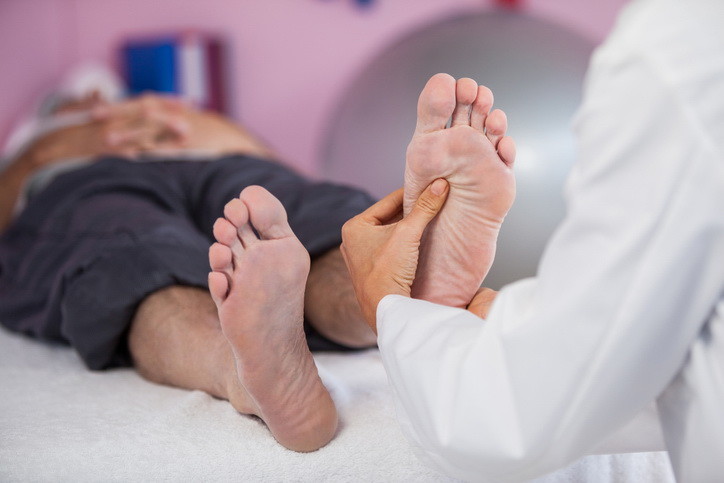It’s common to develop pain and swelling in the ball of the foot after a car accident. If you suspect your foot pain is from a car accident, please call us to arrange a free consultation with one of our Eason & Tambornini personal injury lawyers. Our lawyers will be able to answer any questions you may have about foot injuries, such as the causes of pain and swelling in the ball of the foot, treatments for pain in the ball of the foot, and treatments for a sprained foot. Foot injuries resulting from car accidents can negatively impact your life, so be sure to contact a lawyer.
Learn more about our Sacramento Car Accident Attorney Services.
What causes pain and swelling to the ball of the foot after an accident?
 Car accidents can cause injury to the ball of your foot in two possible ways. One way is when you are about to brake hard with the sole of your foot flexed at 0 degrees or the normal resting foot position. Another common way occurs when your foot is flexed at about 30 degrees to 50 degrees and is resting on the brake pedal or floorboard.
Car accidents can cause injury to the ball of your foot in two possible ways. One way is when you are about to brake hard with the sole of your foot flexed at 0 degrees or the normal resting foot position. Another common way occurs when your foot is flexed at about 30 degrees to 50 degrees and is resting on the brake pedal or floorboard.
During car collisions, the midfoot directly or indirectly sustains excessive force, resulting in numerous injuries like a Lisfranc fracture and ligament injuries. Lisfranc fracture is the dislocation of the metatarsal bones from the tarsal bones, causing immediate pain and subsequent inflammation.
It’s easy to suspect a Lisfranc fracture following a car accident. There will be a noticeable foot deformity suggestive of the dislocation of the bones. X-rays will also confirm the diagnosis.
What are some of the ball of foot pain treatments?
Your doctor may prescribe pain medication and anti-inflammatory drugs to manage the symptoms. You can also apply an ice pack over the swelling for the first three days and then switch to hot packs after that.
If there is a Lisfranc injury and the dislocations of the metatarsals from the tarsals are only about 2 mm, then there’s no need for surgery. Although, the foot may be placed in a cast for six weeks with instructions not to bear weight on the affected foot.
However, if the injuries are severe, surgery becomes an option to repair the damage. Your surgeon may use screws and internal fixators to stabilize the foot and promote proper bone healing.
A Lisfranc fracture can result in foot deformity, chronic pain, and significant loss of foot motions. All of these can affect your day-to-day life and even cause loss of income if the pain starts to affect your professional life.
What is a sprained foot?
Foot sprain caused by the tearing of the foot ligaments resulting from blunt trauma is expected due to car accidents.
The severity of the foot sprain varies. A mild sprain occurs when there’s just minuscule tearing of the ligaments. A moderate sprain occurs when there is partial tearing of the ligaments. Lastly, a severe sprain occurs when there is a complete tear of the ligaments.
Foot sprains typically occur in the midfoot and are commonly caused by sports like competitive diving and windsurfing, high-risk activities like dancing and landing on a twisted foot, and car accidents. Foot sprains caused by car accidents can cause not only ligament tearing but also bone fractures and open foot lacerations as well.
Symptoms of a sprained foot include pain, swelling, and tenderness. There may also be bruising over the injured area, inability to bear weight, gait difficulty, etc.
How do you treat a sprained foot?
A sprained foot usually resolves on its own within a few weeks. Still, you can control the pain and swelling by taking pain and anti-inflammatory drugs. On the other hand, severe foot sprains will usually take two or more months longer to heal than mild or moderate sprains.
Treatments for a mildly sprained foot include RICE – Rest the injured foot, Ice application over the foot, Compress the foot to decrease swelling, and Elevate the foot to reduce swelling. Immobilization like splinting and casting may also be required, but this depends on the severity of your injuries. If completely torn, surgery may be needed to repair the damage to the ligaments.
Call your doctor if the pain doesn’t improve, even with pain meds, as there may be other severe injuries in the foot.
What can you do?
Never take pain and swelling in the ball of the foot for granted since these could mean more severe foot injuries like torn ligaments, bone fractures, and tendon damage. If you or your loved one sustained traumatic injuries following a car accident, know that one of our lawyers can help explain the causes of pain and swelling in the ball of the foot, the causes of foot sprain, and treatments for foot sprain. If you have questions and concerns regarding ball of foot pain and swelling after a car accident or any other types of injuries caused by car accidents, please feel free to call an Eason & Tambornini car accident attorney Sacramento so we can assist you through the legal process.
The information provided on this blog is for informational purposes only and not a substitute for professional medical advice, diagnosis, or treatment. Always seek the advice of your physician or other qualified health provider with any questions you may have regarding a medical condition. Never disregard professional medical advice or delay in seeking it because of something you have read on this blog.
